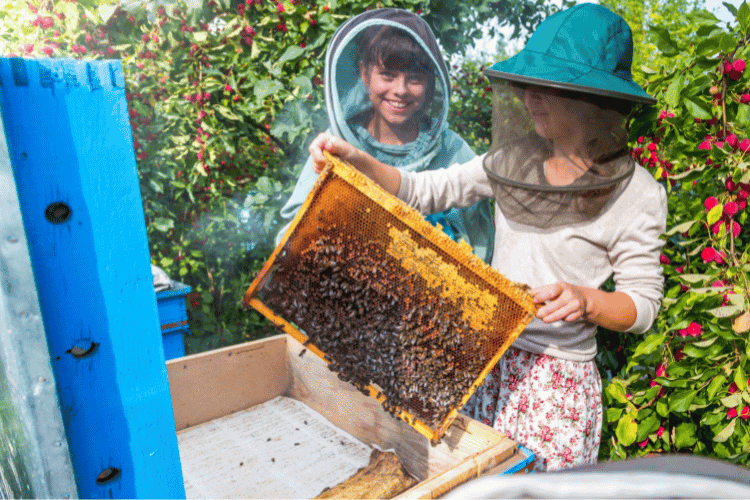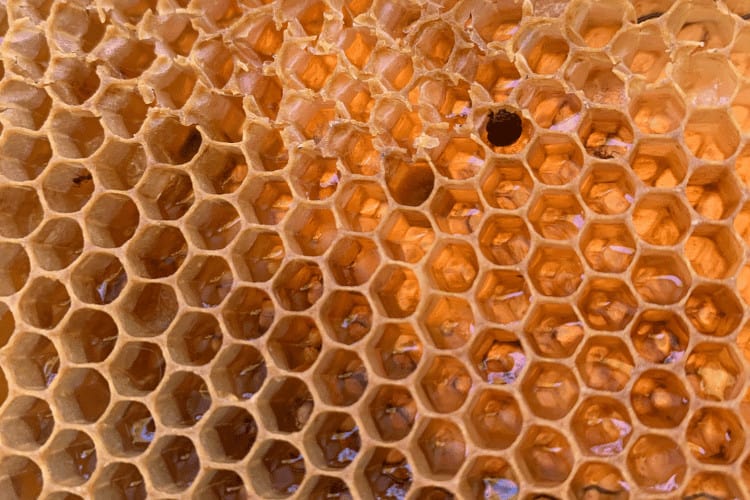Bee Treatments: A Guide to Recognizing and Addressing Common Bee Diseases
Whether you’re an aspiring or a seasoned beekeeper, nothing takes priority over the well-being of your honey-making friends.
The problem is that bee health can sometimes throw us a curveball. Irregular egg patterns, mold growth, and strange odors are among the puzzling problems you can face as a beekeeper. Don’t worry about it, though.
In this article, we’ll explore the world of bee treatments, helping you pick the appropriate cure for several common health issues. From bacteria to parasites, keep reading for all the details!
How to Identify Bee Health Issues

Before we delve into the common bee diseases and their treatments, let’s first discuss some telltale signs of bee health issues.
Irregular Egg Pattern
As you know, a healthy beehive has three distinct types of bees: queen, worker, and drone. The queen is the only active reproductive female and typically lays one egg per cell.
Multiple eggs per cell indicate a laying female worker or parasitic invasion. Such problems won’t go away on their own; you need requeening, among other solutions. That’s why it’s essential to inspect a beehive regularly to identify if your colony is unhealthy and fix the problem early.
Brood Problems
Brood shape is another telltale sign of beehive issues. If you’re unsure, brood is a collective term describing the three developmental stages of bees—eggs, larvae, and pupae. Eggs are hard to see, but you can inspect the larvae—the second stage.
A healthy larva is C-shaped. It also has a pearly white color with a shiny appearance. Each larva occupies one cell in the combs. As it matures, the workers cover the cells with brown, tan, or cream caps different from the honey-protecting ones.
If you notice irregular color or texture, your brood might be infected. Likewise, sunken, greasy-looking dark caps could indicate a disease.
Foul Odor
As a beekeeper, nothing brings you more joy than the mesmerizing smell of honey, beeswax, resins, and brood mix.
Typically, a healthy colony produces a sweet, warm scent. If you dig deeper, you can smell the subtle odor of pine or cedar wood. A diseased hive, on the other hand, produces a foul, rotten egg-like odor.
What Bee Treatments Should You Use for Common Bee Diseases?
As you might know, several parasites and pests can infect your precious buzzing buddies. These include bacteria, mites, and more! Identifying the causal agent and the disease will help you choose the appropriate bee treatment.
Here’s a detailed explanation of common bee illnesses and how to cure them:
1. American Foulbrood
American foulbrood is an infectious, fatal disease. Paenibacillus larvae, a spore-forming bacteria, is the primary culprit behind this brood illness.
Once an infected nursing bee feeds the young larva, this microorganism inhibits the larva’s gut and multiplies rapidly, eventually causing death.
The problem is that these parasites are sneaky. At first, the infected population is unnoticeable; it may take up to a year for the disease to reach its critical stage. In that case, the colony dies during the first season.
Symptoms of American foulbrood (AFB) include moist, dark caps, which sink inside the cell as the larva shrinks. The larva’s color becomes creamy brown and darkens gradually. Additionally, the overall appearance of the brood nest is patchy.
Unfortunately, the late stages of AFB are incurable. You’ll need to burn the frames, bottom boards, and infected beehives. You can also use gamma radiation instead.
Additionally, treat the rest of the colony with Oxytet-25-S or Oxysol-62.5 powdered sugar mix—both of which require a prescription.
3. European Foulbrood
European foulbrood (EFB) is another bacterial disease affecting broods, especially those of western honey bees. Unlike American foulbrood, Melissococcus plutonius is the causal agent of this illness.
Infection occurs through feeding by nurse bees, and the bacteria multiply in the gut. The symptoms include shrunken, rubbery larvae with yellow-brownish shades. A spotty brood pattern and foul odors are also signs of this disease.
You’ll need a specialized detection kit to differentiate between American and European foulbrood.
The good news is that EFB is less severe than AFB. So, you don’t need to burn the hive. Instead, you can treat the colony with Terramycin—Oxytet-25-S or Oxysol-62.5. However, you should only use this antibiotic in the spring and fall before the nectar flow.
You can also use non-chemical treatments, such as adding frames with young and mature broods from healthy colonies.
You can also move adult bees using the shook-swarm method. To do so:
- Set up a new hive using disease-free combs.
- Remove 3-4 frames from the center.
- Find and cage the queen of the infected colony.
- Take one frame from the diseased hive and shake the bees so that they enter the new hive.
- Discard the infected frame.
- Repeat the same process with the remaining frames.
- Put back the healthy beehive frames and release the queen into the new hive.
- Place the queen excluder and treat the colony with the mentioned antibiotics.

3. Chalkbrood
Unlike the above diseases, chalkbrood is a fungal illness caused by Ascosphaera apis. However, like other bacterial infections, this fungus is highly transmissible. The disease cycle begins when foraging bees bring contaminated pollen into the hive.
The fungal spores then inhibit the larva’s gut and multiply. Symptoms appear around two days after the cells are capped. They include swallowed larvae and white, fluffy outgrowths.
The black fungus can also cover the brood and protrude outside the caps, a symptom known as chalkbrood mummies.
Unfortunately, no chemical treatment is available for this disease. However, you can overcome this issue by removing all the infected stock and requeening every spring and fall.
4. Nosema
Nosema is a honey bee disease caused by two types of single-celled parasites: Nosema apis and Nosema ceranae.
Instead of infecting the brood, Nosema species inhibit the guts. Millions of these single-celled organisms can multiply in the bee’s midgut, disturbing its metabolism, among other physiological functions.
As a result, infected insects become weak and susceptible to other pests and infections. Nosema can be transmitted from sick to healthy individuals through ingesting contaminated food or water sources.
Typically, the infected colony doesn’t show physical symptoms. For diagnosis, you need to send about 50 adults to a bee-testing laboratory. Treatment options include requeening from healthy colonies and feeding the colony fumagillin-B with sugar syrup every spring and fall.
5. Sacbrood
As the name suggests, sacbrood is a viral disease that affects bee larvae. The virus can also inhibit adult honeybees but may not show symptoms.
Transmission occurs through infected nursing bees during feeding. Once the virus enters the larva, it prevents it from developing into a pupa—the third stage.
Symptoms include yellowish-brown, watery larvae. The caps become sunken, and dead brood can protrude from them. You can mistake sacbrood for American foulbrood. However, the former illness doesn’t produce a foul odor, unlike the latter.
Currently, no treatments are available for this viral disease. Maintaining a strong, healthy colony and requeening are the only preventative measures.
6. Small Hive Beetle
The small hive beetle (SHB) is a pest invasion that damages stressed bee colonies. Aethina tumida, sub-Saharan African beetles, are the causal agents of this disease.
Once they mature, the small insects seek beehives. They hide in crevices to escape bee aggression. During that time, they steal honeybees’ food and lay numerous eggs. As a result, they damage the colony, reducing honey production and even spoiling it.
Regular examination of brood frames can help you detect those invaders. Treatment options include chemical control, such as GuardStar, a ground drench that kills beetle larvae at the openings.
Following best management and biosecurity practices can also help stop these pests from spreading.

7. Tracheal Mites
Tracheal mites are another parasitic organism affecting honeybees. As the name suggests, these microscopic mites inhibit the tracheae, the breathing tubes of bees. Their life cycle begins when females infect and lay eggs in the respiratory systems of bees.
Once they mature, adult mites penetrate the tracheal wall and feed on bee blood. Of course, that weakens the bees, affecting their flight activity and shortening their lifespan.
The problem is that you can’t detect tracheal mite-infected colonies since there are no symptoms. Only a microscopic examination can help you diagnose this disease.
Methanol crystals or 65% formic acid are effective treatment options for these parasitic mites. Just make sure to take safety precautions and follow the instructions on the label.
8. Varroa Mites
Like the above disease, Varroa mites are parasitic organisms that only reproduce inside bee colonies. They’re one of the most devastating honeybee external pests, causing great economic losses.
Varroa mites live and feed on bees, transmitting from infected to healthy individuals through direct contact. Female mites, however, reproduce only in broods.
Luckily, you can detect these red-brown parasites with the naked eye. Regular inspection of adult bees and broods can help with early diagnosis. Treatment options include 65% formic acid and mite strips, such as Apivar.
Wrapping Up
As you can see, you can use several bee treatments, such as requeening, burning, formic acid, and antibiotics, to overcome many bee diseases.
Regular inspection to detect irregular egg patterns, foul odors, or abnormal bee behavior is also crucial to recognizing bee parasites and pests early and controlling them.
Now, armed with these insights, you’re better equipped to tackle many bee health challenges, ensuring your buzzing friends continue to thrive!
